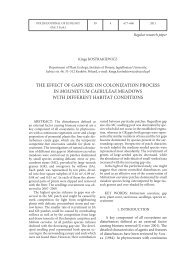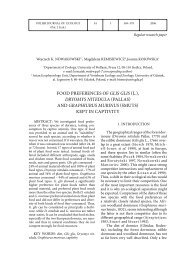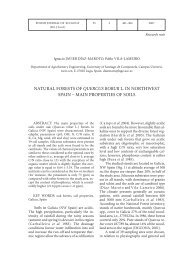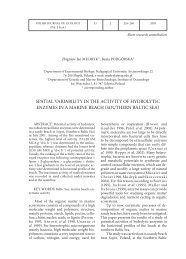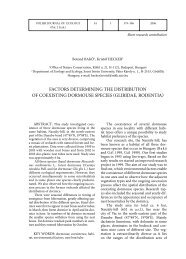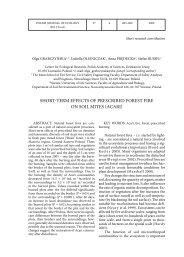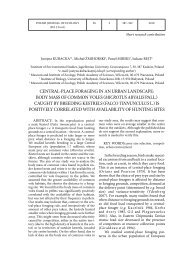HOST SEX AND ECTOPARASITE INFECTIONS OF PLATEAU PIKA ...
HOST SEX AND ECTOPARASITE INFECTIONS OF PLATEAU PIKA ...
HOST SEX AND ECTOPARASITE INFECTIONS OF PLATEAU PIKA ...
Create successful ePaper yourself
Turn your PDF publications into a flip-book with our unique Google optimized e-Paper software.
POLISH JOURNAL <strong>OF</strong> ECOLOGY<br />
(Pol. J. Ecol.)<br />
56 3 535–539 2008<br />
Short research contribution<br />
Haixin CI 1, 2 , Gonghua LIN 1, 2 , Jianping SU 1 , Yifan CAO 1<br />
1<br />
Key laboratory of Adaptation and Evolution of Plateau Biota, Northwest Institute of Plateau Biology,<br />
Chinese Academy of Sciences, Xining 810001, China, e-mail: jpsu@nwipb.ac.cn (corresponding author)<br />
2<br />
Graduate School of Chinese Academy of Sciences, Beijing 100049, China,<br />
e-mails*: haixinci@gmail.com, lingonghua05@mails.gucas.ac.cn<br />
<strong>HOST</strong> <strong>SEX</strong> <strong>AND</strong> <strong>ECTOPARASITE</strong> <strong>INFECTIONS</strong><br />
<strong>OF</strong> <strong>PLATEAU</strong> <strong>PIKA</strong> (OCHOTONA CURZONIAE, HODGSON)<br />
ON THE QINGHAI-TIBETAN <strong>PLATEAU</strong><br />
ABSTRACT: A total of 449 plateau pika<br />
(Ochotona curzoniae Hudgson) individuals were<br />
sampled with rattraps from 21 plots (size 1 ha)<br />
randomly scattered over the area of the species<br />
distribution at the altitude 3275–4807 m a.s.l. in<br />
the Qinghai-Tibetan Plateau (West China). Two<br />
main ectoparasite species Hypoderma satyrus<br />
Brauer and Ixodes crenulatus Neumann of plateau<br />
pika were surveyed, and the relations between<br />
host sex and parasitism were analyzed. The results<br />
were: (i) although not significantly, the infection<br />
rate of female young was close to zero and lower<br />
than that of male young (6%), while the infection<br />
rate of female sub-adults (19%) was contrarily<br />
– higher than that of male sub-adults (11%);<br />
adult females had significantly higher (41%) infection<br />
rate than that of males (18%) (P
536<br />
Haixin Ci et al.<br />
Fig. 1. Sampling locations on Qinghai-Tibetan Plateau (West China )<br />
as parasite taxon and age of hosts might also<br />
affect the sex-specific host-parasite relations<br />
(Amundsen et al. 1997, S chalk and<br />
Forbes 1997, Moore and Wilson 2002).<br />
The various factors and their interrelations<br />
make situations complex (Krasnov et al.<br />
2005), and more data are needed to elucidate<br />
the problems about SBP.<br />
Plateau pika (Ochotona curzoniae<br />
Hudson)is a keystone species on the Qinghai-Tibetan<br />
Plateau, and plays an important<br />
role for biodiversity in the ecosystem (Smith<br />
and Foggin 1999). Several studies have paid<br />
attention to the parasite infections of plateau<br />
pika (Zhang 1991, Cao and Ye 1998, Ding<br />
et al. 1999, Wang et al. 2003). To our knowledge,<br />
however, no studies focused on sex-specific<br />
differences in the parasitism. Since there<br />
are ecological differences e.g. in growth rate<br />
(Zhou et al. 1987) and spacial territory between<br />
male and female plateau pika (Qu et<br />
al. 2007), we suggest there is also SBP in this<br />
species. During July of 2006, when a sampling<br />
aimed to analyze phylogeographic structure<br />
of plateau pika on the Qinghai-Tibetan Plateau<br />
was executed, at the same time we surveyed<br />
the parasite infections in this species<br />
and then investigated the relations between<br />
parasite infections and host sex. The relationship<br />
between sex-specific parasitism and age<br />
of animal was also investigated.<br />
Sampling was conducted in July 2006, at<br />
the annual peak of abundance of plateau pika<br />
(Liang and Qi 1989), in order to increase<br />
trapping efficiency. Pika trappings were carried<br />
out on 21 plots of 1 ha size that were randomly<br />
selected on the plateau, on the area of<br />
the species distribution at altitude 3275–4807<br />
m a.s.l. (Fig. 1). Each plot was sampled in<br />
the day time with ~30 rattraps placed at the<br />
entrances of their burrows. Animals were<br />
decollated by hand immediately after trapping,<br />
and parasite infections and other biological<br />
characters including gender, body<br />
weight, body length, reproduction condition<br />
were measured before tissue for DNA extrac-<br />
journal 15.indb 536 2008-09-23 10:56:07
Host sex and ectoparasite infections of plateau pika<br />
537<br />
Table 1. Total sample size (N), average body mass (M±SD) and infection rate (R) of males and females<br />
in each age-group.<br />
Males<br />
Females<br />
young sub-adults adults young sub-adults adults<br />
N 82 71 114 27 53 102<br />
M (g)<br />
57.12<br />
±13.32<br />
104.06<br />
±10.65<br />
151.07<br />
±22.63<br />
53.30<br />
±16.91<br />
105.17<br />
±10.59<br />
162.19<br />
±30.58<br />
R (%) 6 11 18 0 19 41<br />
tion was collected. The longitude, latitude<br />
and altitude at the centre of each sampling<br />
plot were measured using an Etrex GPS unit<br />
(Garmin, Taiwan).<br />
Although there are many kinds of ectoparasites<br />
and endoparasites in plateau pika<br />
(Ding et al. 1999, Wang et al. 2003), only<br />
two ectoparasite species that could be easily<br />
identified were surveyed in this work since<br />
(i) the parasitism survey was a byproduct<br />
of a sampling aimed to analyze phylogeographic<br />
structure of plateau pika and (ii)<br />
the work conditions in the field on the plateau<br />
was pretty difficult. The ectoparasite<br />
species included in the study – Hypoderma<br />
satyrus Brauer (1858) and Ixodes crenulatus<br />
Neumann (1904) are two most common<br />
parasite species of plateau pika. The maggot<br />
of Hypoderma satyrus usually adheres<br />
to endermic of the back and outboard limbs<br />
(Ding et al. 1999), and could be found by<br />
carefully searching the pika skin. Ixodes<br />
crenulatus individuals usually attach at auricle,<br />
eyelid, cheek, nose lid, inboard foreleg<br />
(Ding et al. 1999) of pikas, and could be<br />
easily identified in these positions. Due to<br />
the relatively low infection rates of either<br />
Hypoderma satyrus or Ixodes crenulatus<br />
alone, the infection data of these two parasites<br />
were combined i.e. pika individuals infected<br />
by either of the two parasite species<br />
were recorded as ‘infected’.<br />
Individuals were grouped according to<br />
their weight and gender in each plot. Three<br />
age-groups were determined based on present<br />
studies both in the field and under the<br />
condition of artificial feeding (Zhou et al.<br />
1987, Ye and Liang 1989): (i) young – no<br />
more than 80g ,(ii) sub-adult – between 80g<br />
and 120g, (iii) adult – more than 120g. Infection<br />
rates of males as well as females were<br />
calculated for each age-group based on all<br />
samplings. Sex-specific parasite infection<br />
rate and related factors were analyzed. The<br />
Independent-Sample T Test was used to test<br />
the differences of body mass between males<br />
and females of each age group. For the comparison<br />
of infection rates among groups with<br />
different gender and age, the small sample<br />
data in each plot were combined and a Crosstabs<br />
analysis was used. All statistical analyses<br />
were executed using SPSS 13.0 for Windows<br />
(SPSS Inc., Chicago, IL, USA).<br />
A total of 449 individuals were sampled<br />
from 21 plots randomly scattered on the Qinghai-Tibetan<br />
Plateau (including Qinghai, Tibet<br />
and Sichuan Province) (Fig. 1). The sampling<br />
covered almost the entire geographical<br />
distribution of the species. The average body<br />
mass and the infection rate of each group are<br />
listed in Table 1. Crosstabs analysis did not<br />
show significant differences between the infection<br />
rates of young and sub-adult males<br />
and females however the respective data were<br />
lower for female young than for male young<br />
(df = 1, P = 0.189), and higher – for female<br />
sub-adults than that for male sub-adults (df =<br />
1, P = 0.235) (Table 1). In adult group, infection<br />
rate of females was significantly higher<br />
than that of males (Crosstabs analysis, df = 1,<br />
P
538<br />
Haixin Ci et al.<br />
Recent related reviews generally emphasized<br />
male biases in parasitism (Poulin<br />
1996, S chalk and Forbes 1997, Wedekind<br />
and Jakobsen 1998, Acuna-S oto<br />
et al. 2000). However, our analysis on adult<br />
age-group showed female biases in ectoparasite<br />
infections. There are two major classes of<br />
hypotheses for the proximate control of SBP.<br />
One claims that males are envisaged to suffer<br />
a sex-specific handicap because of a mechanism<br />
called immunodepressive effect (Klein<br />
2000), while another class of hypotheses suggests<br />
that it is body size per se that is important<br />
in generating SBP either because the larger<br />
sex is exposed more to infection, or because<br />
of the balance of energy investment between<br />
somatic growth and immune function, that<br />
is, the enhanced growth of larger sex reduced<br />
the energy investment on their immune system<br />
and consequently makes them more<br />
susceptible to parasites (Moore and Wilson<br />
2002). We suggest that, in our study, the<br />
biological differences e.g. in body mass and<br />
growth rate had caused the SBP of plateau<br />
pika at different age stages, which is consisted<br />
with Moore and Wilson (2002) findings.<br />
Although not significantly, the weights<br />
of female young were a little lower than male<br />
young (Independent-Sample T Test, df = 107,<br />
P = 0.290) while female sub-adults were a<br />
little heavier than male sub-adults, however<br />
without significance (Independent-Sample<br />
T Test, df = 122, P = 0.565). Moreover, the<br />
growth rate of female pika is lower at young<br />
stage but higher at juvenile (sub-adult) stage<br />
than that of the males (Zhou et al. 1987).<br />
As to the adults, female adults (including 31<br />
pregnant individuals) were also significantly<br />
heavier than male adults (df = 214, P
Host sex and ectoparasite infections of plateau pika<br />
539<br />
Amundsen P.A., Kristoffersen R., Knudsen<br />
R ., Klemetsen A. 1997 – Infection<br />
of Salmincola edwardsii (Copepoda: Lernaeopodidae)<br />
in an age-structured population of<br />
Arctic charr – a long-term study – J. Fish Biol.<br />
51: 1033–1046.<br />
Brei B., Fish D. 2003 – Comment on “Parasites<br />
as a viability cost of sexual selection in<br />
natural populations of mammals” – Science,<br />
300: 55a.<br />
Cao Y.F., Ye R .R . 1998 – Survey of helminthes<br />
parasitism of plateau pika – Chin. J. Vet. Sci.<br />
Tech. 28 (5): 14–15 (in Chinese with English<br />
abstract).<br />
Ding X.T., He X.Q., Cao Y.Q., Dai L.<br />
1999 – Reports on parasite infections on plateau<br />
pika – Sichuan J. Zool. 18 (1): 34–43 (in<br />
Chinese).<br />
Klein S.L. 2000 – The effects of hormones on<br />
sex differences in infection: from genes to<br />
behavior – Neurosci. Biobehav. Rev. 24: 627–<br />
638.<br />
Krasnov B.R., Morand S., Hawlena H.,<br />
Khokhlova I.S., Shenbrot G.I. 2005 –<br />
Sex-biased parasitism, seasonality and sexual<br />
size dimorphism in desert rodents – Oecologia,<br />
146: 209–217.<br />
Liang J.R., Qi G.X. 1989 – The population<br />
age structure and dynamics of the plateau<br />
pika (Ochotona curzoniae) – Acta Theriol.<br />
Sin. 9 (3): 228–230 (in Chinese).<br />
McCurdy D.G., Shutler D., Mullie A.,<br />
Forbes M.R . 1998–Sex-biased parasitism<br />
of avian hosts: relations to blood parasite taxon<br />
and mating system–Oikos, 82: 303–312.<br />
Moore S.L., Wilson K. 2002–Parasites as<br />
a viability cost of sexual selection in natural<br />
populations of mammals–Science, 297: 2015–<br />
2018.<br />
Poulin R. 1996–Sexual inequalities in helminth<br />
infections: A Cost of Being a Male?–Amer.<br />
Naturalist. 147 (2): 287–295.<br />
Poulin R., Curtis M.A., Rau M.E. 1991–<br />
Size, behaviour, and acquisition of ectoparasitic<br />
copepods by brook trout, Salvelinus fontinalis<br />
– Oikos, 61: 169–174.<br />
Qu J.P., Li K.X., Yang M., Li W.J., Zhang<br />
Y.M., Smith A.T. 2007–Seasonal dynamic<br />
pattern of spacial territory in social groups<br />
of plateau pikas (Ochotona curzoniae) – Acta<br />
Theriol. Sin. 27(3): 215–220 (in Chinese with<br />
English abstract).<br />
Reimchen T.E., Nosil P. 2001 – Ecological<br />
causes of sex-biased parasitism in threespine<br />
stickleback – Biol. J. Linn. Soc. 73: 51–63.<br />
Schalk G., Forbes M.R. 1997 – Male biases<br />
in parasitism of mammals: effects of study<br />
type, host age, and parasite taxon – Oikos, 78:<br />
67–74.<br />
Smith A.T., Foggin J.M. 1999–The plateau<br />
pika (Ochotona curzoniae) is a keystone species<br />
for biodiversity on the Tibetan plateau<br />
– Anim. Conserv. 2: 235–240.<br />
Wan X.R., Liu W., Zhao T.B., Jing Y.,<br />
Guo P.F., Shi Y.S., Wang G.H. 2007<br />
– Relationship between the infective characters<br />
of Capillaria hepatica and the body mass<br />
of the Brandt’s vole (Lasiopodomys brandtii)<br />
– Acta Theriol. Sin. 27 (2): 165–169 (in Chinese<br />
with English abstract).<br />
Wang Z.D., Fang W., Ma J., Zhang Y., Cai<br />
J.F., Han D.H., Lv R ., Zhong X.Y. 2003<br />
– Effectiveness of Expelling Endoparasiteand<br />
Ectoparasite of wild plateau pika – Chin. Qinghai<br />
J. Anim. Vet. Sci. 33 (6): 22–23.<br />
Wedekind C., Jakobsen P.J. 1998 – Malebiased<br />
susceptibility to helminth infection: an<br />
experimental test with a copepod – Oikos, 81:<br />
458–462.<br />
Wilson K., Moore S.L., Owens I.P.F. 2003<br />
– Response to Comment on “Parasites as a<br />
Viability Cost of Sexual Selection in Natural<br />
Populations of Mammals” – Science, 300: 55b<br />
Ye R.R., Liang J.X. 1989 – Study on the<br />
growth and development of plateau pika under<br />
the condition of artificial feeding – Acta<br />
Theriol. Sin. 9 (2): 110–118 (in Chinese with<br />
English abstract).<br />
Zhang G.D. 1991 – Fleas, ticks and mites in<br />
plateau pika in Qinghai – Chin. J. Vect. Biol.<br />
Contr. 2: 131–133 (in Chinese).<br />
Zhou L., Liu J.K., Liu Y. 1987 – Studies on<br />
population productivity ecology of the plateau<br />
pika (I). A dynamic model of growth of<br />
body weight in the plateau pika – Acta Theriol.<br />
Sin. 7 (1): 67–78 (in Chinese with English<br />
abstract).<br />
Zuk M., Mckean K.A. 1996 – Sex differences<br />
in parasite infections: patterns and process<br />
– Int. J. Parasitol. 26: 1009–1024.<br />
Received after revising March 2008<br />
journal 15.indb 539 2008-09-23 10:56:09




